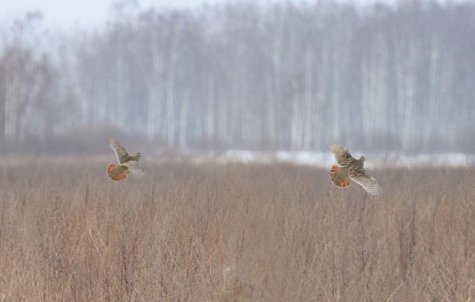Birder's diary - 100 species passed!
Birder: Margus Ots, linnuvaatleja.ee
Translation: Liis
January 23rd – 100 species passed at last!
Already yesterday it seemed that there were a couple of lighter-coloured birds among the redpolls at the Aardlapalu landfill, but they were too far away to be identified as arctic redpolls and it wasn’t possible to get closer. So today I went again to have another look. This time the birds were close to the road and they could be seen better, face to face. Among some 120 redpolls at least 2 or even 3 arctic redpolls stood out. The bird flock moved around rather nervously on the fallow field and it was difficult to see precisely how many they were. Identifying arctic redpolls is not at all easy because even among common redpolls there are paler individuals. But as the Estonian name, hele-urvalind - light redpoll, implies, the Arctic redpoll is clearly lighter (with a white base colour) than the common redpoll; the streaking on the flanks is lacking or almost so, and the rump area is pure white without streaks. In order to identify this species all characteristics must be clearly seen and for this the birds must be very close.
Such is a fox's view when partridges escape from it (Aardlapalu, 23.01.2012)
While I was busy with identifying the arctic redpolls 5 partridges passed just in front of me. In the dense vegetation they would almost have gone unobserved. Partridges have become a quite rare species in Estonia in recent years; the main reason for the decrease is believed to be the increase of smaller predators. The partridges have simply been gobbled up by foxes and other creatures. But the excitement of the partridge observation came from the fact that this species turned out to be the 100th bird species in my 2012 list!
Inspired by these observations I decided to go back to Haaslava where kingfishers had been seen a few hours earlier. I found the dipper again at once but a kingfisher was nowhere to be seen. I decided to walk along the river bank in the forest, maybe the kingfishers were somewhere ambushing their prey. But in the deep snow I did not notice that some underground diversionist, probably a beaver, had set a trap for me. Anyway, I fell into a hole and got wet, and today’s bird trip was at an end. Crashing out from the coppice I set a large flock of tits moving. A long-tailed tit showed up among them, and this was the 101st species on my 2012 list. At least some good came from the splash.
Earlier I already wrote that collecting 100 species until the second half of January was no special feat. In the warm winter of 2009 the toughest birders had reached 100 species already on January 3 and 4. But I had not planned for a rush start with hard work at once in the beginning of the year, the aim is after all the year record. In my old notebooks I saw that in 2002, when I saw 262 species, a year record, I found the 100th species only on March 28. So, the current stand is not the worst. But when will the 200 species limit be passed? Some time in early May, experience shows, with the arrival of the corn crake and the swift.









